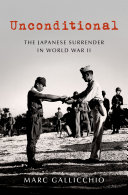2018 School Spending Survey Report
Unconditional: The Japanese Surrender in World War II
COPY ISBN
VERDICT A scholarly work, this will appeal most to researchers and informed readers interested in the diplomatic history of World War II.
RELATED
ALREADY A SUBSCRIBER? LOG IN
We are currently offering this content for free. Sign up now to activate your personal profile, where you can save articles for future viewing




Comment Policy:
Comment should not be empty !!!